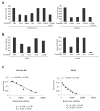Receptor usage of a newly emergent adenovirus type 14
- PMID: 19307010
- PMCID: PMC2674115
- DOI: 10.1016/j.virol.2009.02.034
Receptor usage of a newly emergent adenovirus type 14
Abstract
Recently, cases of severe respiratory illness in military and civilian populations have been associated with a new genomic variant of adenovirus (Ad) serotype 14, designated Ad14a. Compared to the Ad14 reference strain (de Wit), this new virus had a deletion of two amino acid residues in the fiber protein knob. Here we tested whether this mutation changed receptor usage of Ad14a compared to Ad14-de Wit. Competition studies with radio-labeled viruses revealed that both Ad14-de Wit and Ad14a used the same receptor which is hitherto unknown. We also found that recombinant fiber knobs only partially blocked attachment of Ad14a, indicating that virus capsid proteins other than the fiber are involved in infection.
Figures




References
-
- Brandt CD, Kim HW, Vargosko AJ, Jeffries BC, Arrobio JO, Rindge B, Parrott RH, Chanock RM. Infections in 18,000 infants and children in a controlled study of respiratory tract disease. I. Adenovirus pathogenicity in relation to serologic type and illness syndrome. Am J Epidemiol. 1969;90 (6):484–500. - PubMed
-
- Chen HL, Chiou SS, Hsiao HP, Ke GM, Lin YC, Lin KH, Jong YJ. Respiratory adenoviral infections in children: a study of hospitalized cases in southern Taiwan in 2001--2002. J Trop Pediatr. 2004;50 (5):279–84. - PubMed
-
- Durmort C, Stehlin C, Schoehn G, Mitraki A, Drouet E, Cusack S, Burmeister WP. Structure of the fiber head of Ad3, a non-CAR-binding serotype of adenovirus. Virology. 2001;285 (2):302–12. - PubMed
-
- Gaggar A, Shayakhmetov D, Lieber A. CD46 is a cellular receptor for group B adenoviruses. Nature Medicine. 2003;9:1408–1412. - PubMed
Publication types
MeSH terms
Substances
Grants and funding
LinkOut - more resources
Full Text Sources
Other Literature Sources

